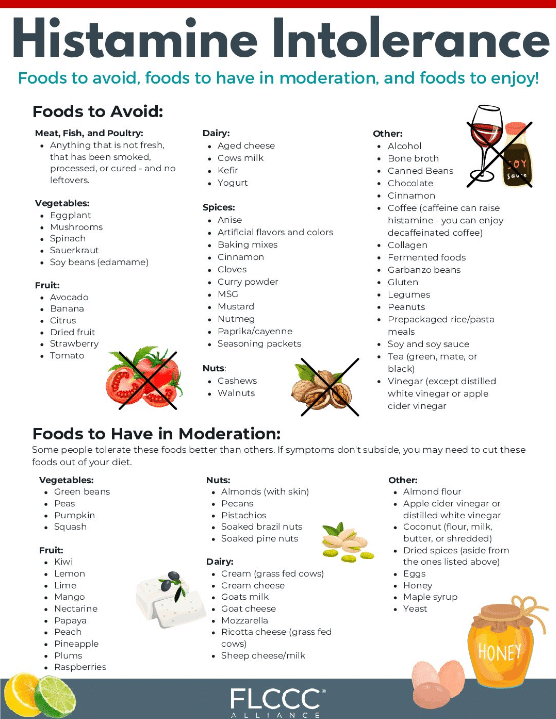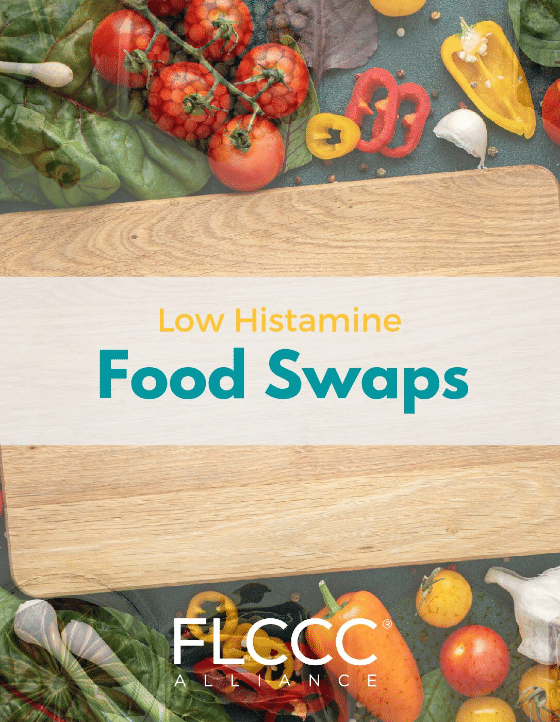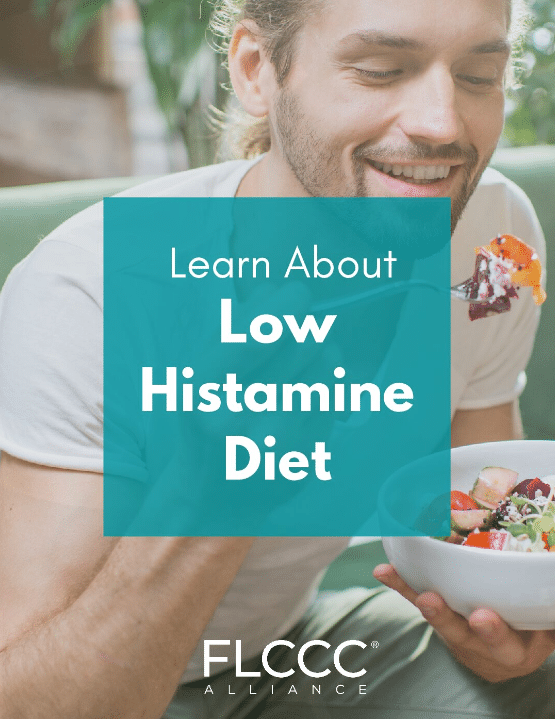Need a low-histamine food list? We’ve got a list of 100+ low-histamine foods to avoid, enjoy in moderation, and swap!

If you’ve ever felt odd after eating certain foods, you might be dealing with histamine intolerance. Histamine is a chemical that plays a bunch of roles in your body, but sometimes things get out of whack. This guide will help you figure out what to eat and what to skip, focusing on a low-histamine diet to keep you feeling great.
This isn’t a diet you’ll need to stick to forever. You’ll just want to reduce histamines for a period to give your body a chance to recover. Foods low in histamine are easier to digest and could allow the body to heal and restore better metabolic function.
- What’s the Deal with Histamine?
- Symptoms of Histamine Intolerance
- How to Diagnose Histamine Intolerance
- Eight Rules for Low-Histamine Eating
- Your Go-To Low-Histamine Diet Food List
- Tips for Long-Term Management
Let’s get started! Take a look at the low-histamine food list PDF below. Then, read more to learn about why this list of low-histamine foods is so important.
1. What’s the Deal with Histamine?
Before we dive into the food list, let’s talk about what histamine does. It’s involved in your immune system, helping your body fight off invaders. But, it can cause trouble when there’s too much of it around, leading to symptoms like headaches, stuffy noses, or stomach issues. This is where a low-histamine diet and understanding histamine levels in food come into play.
Learn more: What is a low-histamine diet?
2. Symptoms of Histamine Intolerance
If you’re frequently getting symptoms like hives, fatigue, digestive issues, or seasonal allergy symptoms, you might be experiencing symptoms of histamine intolerance. It’s your body telling you it’s having a hard time breaking down histamine, which can be due to factors like low diamine oxidase (DAO) enzyme activity, which is crucial for breaking down histamine.
3. How to Diagnose Histamine Intolerance
Before we get to the low-histamine food list, how do you know if you actually have histamine intolerance? It’s a bit tricky to diagnose histamine intolerance because the symptoms can look a lot like other allergies or intolerances.
Health professionals might suggest an elimination diet where you cut out high-histamine foods for a while and then slowly reintroduce them to see how you react.
4. Eight Rules for Low-Histamine Eating
- Eat only fresh meats, fish, and poultry (ground meats may be aged, so be cautious).
- Gauge your response to fish (should be frozen immediately, sockeye salmon typically is).
- Avoid leftovers.
- Avoid artificial sweeteners, preservatives, and colors.
- Prefer high-quality foods:
- Meat: Grass-fed and organic.
- Poultry and Eggs: Pasture-raised and organic.
- Fish: Wild-caught.
- Opt for organic fruits and vegetables when possible.
- Limit cooking time (avoid slow cookers). Pressure cooking (Instapot) is recommended to reduce lectins, problematic for those with histamine intolerance.
- Meal prep is possible; freeze food immediately after cooking.
- Ideal foods for freezing include pre-made sauces (use silicone ice trays), turkey or beef patties, egg muffins, and muffins made with cassava, tiger nut, or almond flour, plus soups and stir-fry.
5. Your Go-To Low-Histamine Diet Food List
Low-Histamine Foods to Definitely Enjoy
- Fresh Meat: Incorporating fresh meat into your diet is a great way to enjoy protein without the worry of increasing amounts of histamine in your body. Freshly cooked beef, chicken, duck, and flash-frozen seafood are fantastic choices for keeping histamine levels low.
- Vegetables: Load up on artichokes, carrots, and kale among others for their low histamine content.
- Fruits: Apples, blackberries, and melons are great for satisfying your sweet tooth without the histamine spike.
- Grains and More: Amaranth, quinoa, and rice are safe bets for keeping your meals interesting.
- Dairy Alternatives: Opt for alternatives like almond milk and coconut oil to keep dishes delicious and low in histamine.
Foods to Enjoy in Moderation
It’s all about balance! If you refer to our low histamine food list pdf, you’ll see a list of foods that you can consider limiting. This list includes foods like green beans, kiwis, peaches, and cream cheese. Test them out and see how you feel.
Foods to Watch Out For
Here’s what to skip to keep histamine at bay:
- Fermented Foods: Sauerkraut, kefir, and yogurt, rich in histamine, should be avoided.
- Processed Meats: Stay away from smoked, processed, or cured meats and no leftovers.
- High Histamine Veggies and Fruits: Eggplant, mushrooms, avocados, bananas, and citrus fruits are on the no-no list.
With these specific details, we’re giving you a clearer road map to managing your histamine levels effectively!
6. Tips for Long-Term Management
Remember, managing histamine intolerance is a marathon, not a sprint. It’s about making informed choices, like opting for fresh over processed foods and understanding the role of enzymes like DAO in breaking down histamine.
Understanding Mast Cells and Histamine Liberators
- Mast Cells: Simply put, mast cells are part of your immune system and store histamine. When they release histamine, it can lead to allergic reactions or symptoms of histamine intolerance.
- Histamine Liberators: Certain foods can prompt mast cells to release histamine, acting as histamine liberators. Avoiding these can be key in a low histamine diet. Although not all liberators are high in histamine themselves, they can exacerbate symptoms by causing the release of stored histamine.
Wrapping Up
Adopting a low histamine diet can be a game-changer in managing intolerance symptoms. With this enhanced guide, you’re equipped to make food choices that help you feel your best. And if things get tricky, don’t hesitate to seek advice from a healthcare professional.
And if you want to learn more about low-histamine diets, check out our PDF guide on the topic below:





